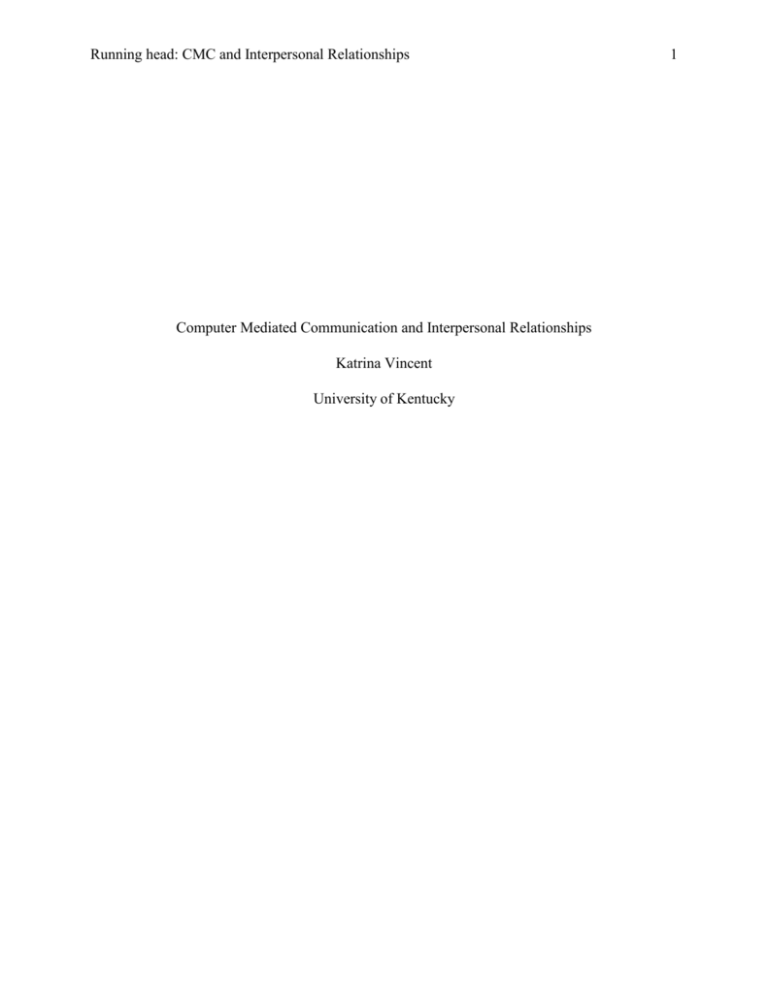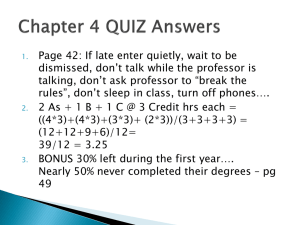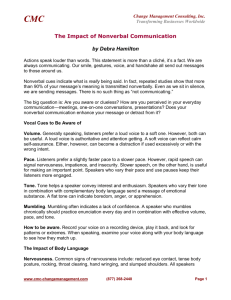Computer Mediated Communication and Interpersonal Relationships
advertisement

Running head: CMC and Interpersonal Relationships Computer Mediated Communication and Interpersonal Relationships Katrina Vincent University of Kentucky 1 CMC and Interpersonal Relationships 2 Abstract In today’s society, Computer Mediated Communication (CMC) is heavily relied upon for people to keep in touch, whether they are down the street or across the globe. CMC includes textmessaging, e-mail, social media sites, phone calls, video calls, etc. Although CMC is used more often in today’s world than in the past, it has yet to replace face to face communication (FtF; Ean, 2013). Some people believe that CMC has only a negative impact on various relationships such as friendships, family, and romantic connections. However, much research has been done to prove that there are a number of benefits in using CMC, (Adler & Proctor, 2013). Steve Jobs has been quoted in saying that personal computers should be renamed “interpersonal computers”, (Adler, et al., 2013). Self-disclosure and identity management are among the specific topics that will be explained and related to CMC as it pertains to interpersonal relationships. The following review is meant to show the good that can come from CMC, but the negative effects will also be discussed. Keywords: CMC, self-disclosure, friendship, Facebook, social media, identity management, family, romantic relationships CMC and Interpersonal Relationships 3 Computer Mediated Communication and Interpersonal Relationships CMC is a highly discussed topic in this day and age. Friends, family members, and people dating or married take advantage of the benefits of CMC. There are some who claim that CMC is not entirely negative as some like to believe, but they also agree that there are times when it can have detrimental effects on different relationships. Computer Mediated Communication (CMC) has many effects on different interpersonal relationships: friendships, family relations, and romantic connections which can be positive or negative, sometimes both on the same relationship. Friendships and CMC To look at friendships and the effect of CMC, you must first look at self-disclosure. Selfdisclosure is “the process of deliberately revealing information about oneself that is significant and would not normally be known by others”, (Adler, et al., 2013). Research shows that people seem to have an easier time revealing more personal information over the internet or SMS than in person. Instead of the self-disclosure there is also a term used for SMS known as CMC disclosure. It is the use of emoticons and text messages sent back and forth between friends (Anderson & Wang, 2005). Some reasons that self-disclosure is perceived as being easier through CMC are a sense of disinhibition and identity management. Disinhibition means to speak before thinking about what one will say. Identity management is a broad topic. People tend to have multiple selves, or different “faces” they reveal when communicating with various people. Some are private and some are public (Adler, et al., 2013). For example, on Facebook someone might give off the impression they are studious and moral. This person may also have a Twitter account and on this social networking site they may give the impression that they like to party or do not care about their studies as much. They may consider their Twitter feed their more CMC and Interpersonal Relationships 4 open self, where their Facebook account might be for family or potential employers. Another example is found in an interview hosted by Katie Davis (2009). In this interview some girls said they used a blogging website called LiveJournal to help maintain their current friendships. They said the website also helped them find their own voice and opinions concerning different things. This helped them find out more about themselves during their high school years. They also said the blogs gave them more insight into their friends’ lives that they would not have received in Face-to-Face (FtF) interaction. They were able to see different experiences through the blog author’s eyes rather than their own. On the other hand a few of the girls said they felt strange knowing so much about their online friends when there was little interaction outside of LiveJournal (Davis, 2009). Anderson and Wang (2005) said in their article about self-disclosure and long distant friendships (LDFs) that because of the growing number of easily accessible communication tools, the impact of geographic location are lessening. People are better able to stay in touch over long distances, whether it is states away or on the other side of the world. Family and CMC One article said college students use e-mail to communicate with family multiple times a week (Johnson, Haigh, Becker, Craig, & Wigley, 2008). On the flip side of this opinion is what Ball, Wanzer, and Servoss (2013) say in their article about parent and child communication through Facebook. They say that young adults typically do not want to accept their parents’ friend requests because they feel they may disappoint their parents with what they post or that their parents will become even more concerned about what they are doing, where they are, who they are with. CMC and Interpersonal Relationships 5 Family dynamics can be universal in their communication styles regardless of how “normal” or dysfunctional they may be. The use of CMC has to do with the pattern of communication in the family. A family can be conversational or conformity oriented (Adler, et al., 2013). Conversational orientation refers to how open a family is with their communication. Conformity orientation refers to how uniform and rule driven a family is. A family higher on the conversational orientation scale will be more likely to benefit from CMC. A student away at college will want to call mom or dad out of pure desire to talk to them, not out of obligation because it is what is expected of him. A study done on the use of cell phones in regards to parent and child relationships concluded various results: some young adults said they rarely used their phones to “just chat” with their parents. Parents agreed that they rarely spoke to their children in a “chit-chat” way; the phones were primarily used for specific reasons (Devitt & Roker, 2009). Instead young adults typically had a specific reason for contacting them. Others said they enjoyed the convenience of their cell phone and the freedom it provided. They said they could call their mom or dad when they were done spending time with friends and ready to return home. Some were even allowed to stay out longer because they had their phones. Romance and CMC Romantic relationships can be maintained the same ways as friendships and family relationships using CMC. There was a study done looking at online relationships and the satisfaction of those relationships. These relationships were strictly online and had no contact outside of CMC. The researchers found that the couples in the study were satisfied in their relationships; however there were similarities in their online relationships and FtF relationships. Trust was the main aspect discussed in comparison of online and FtF relationships. Another CMC and Interpersonal Relationships 6 comparison made was that the length of the relationship had less to do with satisfaction than how often the couples communicated. Those who interacted more often were happier than those who did not; regardless of how long they had been together (Anderson & Emmers-Sommer, 2006). Adler and Proctor say that romantic relationships require maintenance (2013, p. 299). In a study they looked at female college students. These women said openness and mutual problemsolving were necessary to maintain long distance relationships (Adler, et al., 2013). Without the vast amount of communication tools CMC offers this maintenance, it can be said, would be much more difficult for couples. According to another article, Facebook has changed the way romantic relationships form. The author looked at Knapp’s Relational Stage Model (1978) and how Facebook had influenced the escalating stages (“Relationship Development Via Facebook”, 2012). There are five stages in the Knapp’s Model for beginning relationships. These stages are initiating, experimenting, intensifying, integrating, and bonding (Adler, et al., 2013). Facebook has changed the way people initiate relationships. Before social networking sites (SNSs), if two people had a conversation and one was interested in the other they would ask for each other’s numbers. Now with Facebook and other SNSs, a person can avoid having to ask for the number right away by sending a friend request on Facebook and continuing conversation through private messages. If it appears to be going well, then the phone number exchange can happen with a lesser chance of rejection (“Relationship Development Via Facebook”, 2012). This brings it back to the discussion of self-disclosure within CMC. People are more comfortable sharing more personal information through SNSs and text messaging because they do not have to see the other person’s reactions; their non-verbal cues (Adler, et al., 2013). They get to the point of their conversation much quicker with leaner messages. A person may say CMC and Interpersonal Relationships 7 more in a short text message than they could in a FtF conversation because they cannot see the receiver’s face. The sender does not have to worry about potential rejection or other unwanted emotions. The main implication is that there needs to be more research on long distance relationships. The current research is informative and gives much insight into the topics of CMC and interpersonal relationships. Friends, family, and those dating or married can take advantage of CMC in various ways. This does not mean that CMC should be solely relied upon as the only means of communication; there can be negative effects on different relationships. CMC will continue to be a topic of discussion with the ever changing technology of this day and age. Future research should look at the benefits of CMC and its role in long distance relationships between friends, family, and romantic relationships. Look at specific benefits people can gain from using CMC in their different relationships. Researchers should also look at the impact that CMC is having on these long distance relationships; look into potential negative effects. CMC and Interpersonal Relationships 8 References Adler, R. B., & Proctor, R. F. (2013). Looking out, looking in (14th ed.). Belmont, CA: Wadsworth, Cengage Learning. Andersen, P., & Wang, H. (2005). Self-disclosure in long-distance friendships: a comparison between face-to-face and computer-mediated communication. Conference Papers -International Communication Association, 1-44. Anderson, T., & Emmers-Sommer, T. (2006). Predictors of relationship satisfaction in online romantic relationships. Communication Studies, 57(2), 153-172. doi:10.1080/10510970600666834 Ball H., Wanzer M. B., Servoss T. J. (2013). Parent–child communication on Facebook: family communication patterns and young adults' decisions to “friend” parents. Communication Quarterly, 61(5) Davis, K. (2009). Adolescent friendships on LiveJournal. Rocky Mountain Communication Review, 6(1), 47-50. Devitt, K., & Roker, D. (2009). The role of mobile phones in family communication. Children & Society, 23(3), 189-202. doi:10.1111/j.1099-0860.2008.00166.x Johnson, A., Haigh, M. M., Becker, J. H., Craig, E. A., & Wigley, S. (2008). College students’ use of relational management strategies in email in long-distance and geographically close relationships. Journal Of Computer-Mediated Communication, 13(2), 381-404. doi:10.1111/j.1083-6101.2008.00401.x The role of Facebook in romantic relationship development: an exploration of Knapp's relational stage model. (2012). Conference Papers -- International Communication Association, 132.



